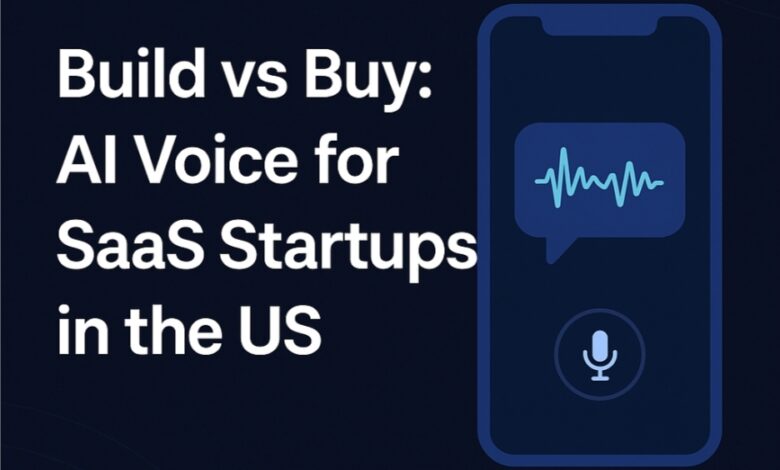Build vs Buy: AI Voice Support for SaaS Products in the US

The rise of voice AI is reshaping how SaaS products engage users. From automated onboarding to hands-free support, voice assistants are no longer futuristic – they’re becoming a must-have feature, especially for US-based startups aiming to improve customer experience without bloating their support teams. But here’s the big question, should you build your own AI voice assistant from scratch or buy an off-the-shelf solution?
This post will walk you through both paths, with real-world context, cost breakdowns, and use cases we’ve seen across SaaS companies in the US. Whether you’re still pre-PMF or scaling fast post-launch, this guide is built to help you decide the smartest next move.
Who Should Read This
This guide is for SaaS founders, product managers, and startup CTOs – especially those in the US – who are exploring whether to build AI voice assistant features from scratch or integrate with existing tools. If you’re launching a product, scaling support, or improving UX using voice tech, this will help you make the right call.
Why Voice AI Is Getting Real for SaaS
Voice AI isn’t just a hype wave anymore. It’s already helping SaaS startups in the US cut support costs, onboard users faster, and offer hands-free product experiences. From fintech to healthtech to accounting software, voice tech is showing up in onboarding flows, customer support, and even in-app guidance.
According to Gartner, over 60% of customer service interactions in the US are projected to be automated by 2025, and voice is playing a huge role. Startups are adopting voice AI not just to be trendy, but to actually reduce repetitive tickets, improve user engagement, and create smoother workflows without growing headcount.
Build or Buy? The Big Question
One of the most common things we hear from startup teams is this: Should we build this voice assistant in-house or just plug in a ready-made solution?
There’s no one-size-fits-all answer. It depends on your product stage, technical team, and how important voice is to your overall value proposition. In this blog, we’ll break down the pros and cons of each path, based on real use cases and client conversations in the US SaaS space.
What It Takes to Build Voice AI (Time, Cost, Team)
Building a voice assistant from scratch sounds appealing. You get full control over the user experience, tailor it exactly to your product, and own the intellectual property.
But that control comes at a cost.
To start, you’ll need 3 to 6 months minimum just for the initial version. You’ll need backend developers, AI/ML engineers, product owners, and QA testers. And then there’s the tech stack: speech-to-text APIs like Deepgram or Google, NLP training models, fallback logic, audio filtering, and secure infrastructure.
Custom voice assistant development isn’t a weekend sprint. It’s a product cycle. Costs typically range from $30K to $80K+ depending on complexity. And after launch, you’ll still need ongoing support to handle updates, improve the model, and adapt to real-world usage (like noisy environments or different accents).
What You Get When You Buy
Now let’s look at the other path. Instead of building, you could use an API-based solution like Vapi, Retell, or Bland.AI.
These tools let you embed a conversational voice AI into your app in just a few days. Most of the heavy lifting – speech recognition, natural language understanding, and fallback handling – is already done for you.
That means faster time to market, lower upfront costs, and zero need to train a model from scratch. You can get started with $0 to $500 in setup, and monthly usage costs are easy to track.
However, you trade off some control. Custom workflows may not be possible. Some services charge per minute or call, and vendor lock-in becomes a consideration.
Still, for early-stage SaaS startups in the US, buying is often the fastest path to validate if voice AI even matters to your users. Why spend months on development when a weekend integration can give you user feedback?
Cost Breakdown: US SaaS Context
Let’s break down the real cost comparison. This is based on what we’ve seen with clients and internal projects.
| Category | Build From Scratch | Buy / Integrate |
| Initial Cost | $30K – $80K+ | $0 – $500 (setup) |
| Monthly Cost | Infra + Dev ($2K–5K) | API use ($50–$300) |
| Dev Time | 3–6 months | 1–3 days |
| Flexibility | High | Medium |
| Support/Updates | Your team | Vendor handled |
This kind of breakdown helps founders see how much delay or burn they might take if they commit to a custom solution too early. For US-based SaaS startups, especially, where every sprint counts, getting to market fast often matters more than owning every line of code.
Decision Matrix: Which One’s Right for You?
Here’s how we usually guide founders at decision time.
You should probably buy if:
- You’re pre-PMF or still validating core features
- Budget is limited
- You just want to test a voice use case fast
- Your team doesn’t have AI/ML experience
You should build if:
- You’re post-PMF with 10K+ users
- Voice is central to your UX or product moat
- You want full control over user flows
- You’re building a platform, not just a feature
There’s also a middle path. Start with a plug-in voice API. If your users love it and the usage grows, plan a custom build later with your own workflow and infrastructure.
What We Do at RaftLabs
At RaftLabs, we help SaaS founders make this exact decision. We work with teams to understand where they are and what makes the most sense:
- Need to go fast? We integrate APIs like Deepgram, Retell, or Vapi in a few days.
- Want more control? We handle custom voice assistant development using open-source NLP tools and hosted models.
- Not sure? We evaluate total cost of ownership, team skillset, and product roadmap to recommend what fits your case.
We’ve worked on voice-enabled apps for fintech, healthcare, and e-learning startups across the US. From basic voice onboarding bots to advanced contextual assistants, we can help you scope, test, and scale voice AI the right way.
We’re also exploring new frontiers for Voice AI, including integrations with AI voice chatbots and intelligent voice agents for more dynamic, real-time interactions, and have already delivered successful projects for our clients in these areas. Read the full guide
Final Thoughts: Save Time or Own the Stack?
Here’s the truth: AI voice assistants aren’t just a cool feature anymore – they’re a real advantage if used right. But not every product needs a full-blown AI team on day one.
So the real question isn’t just build vs buy. It’s: what gets you real usage, real feedback, and real value – fastest?
If voice is a core feature that will shape your product’s future, start thinking custom. If you’re still validating, start simple.
Whatever you choose, don’t overbuild early. Start with value, test in the wild, and scale once the signals are clear.
And if you’re unsure where to begin? Just drop us a message. We’ve helped dozens of SaaS products go from voice idea to working prototype without drowning in dev time.




